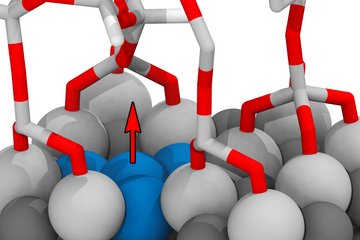All genres
701.
Talk
Mikromechanik: lokale Einblicke in die mechanischen Eigenschaften von Materialien. Eröffnung des Christian Doppler Labors für
Lebensdauer und Zuverlässigkeit von Grenzflächen in komplexen Mehrlagenstrukturen der Elektronik „RELAB“, Vienna, Austria (2015)
702.
Talk
Transformation de phase induite par déformation plastique sévère des aciers perlitiques. XIe Colloque Rayons X & Matière, Grenoble, France (2015)
703.
Talk
New insights into the mechanical behavior of interface controlled metals. Colloquium Materials Modelling, Institut für Materialprüfung, Werkstoffkunde und Festigkeitslehre (IMWF), Universität Stuttgart , Stuttgart, Germany (2015)
704.
Talk
Deformation-driven phase transition in severely cold-deformation pearlitic steel. General Meeting on the Mechanics of Nano-Objects, Marseille, France (2015)
705.
Talk
Differences in deformation behavior of bicrystalline Cu micropillars containing different grain boundaries. MS&T 2015 (Materials Science and Technology) meeting, symposium entitled "Deformation and Transitions at Grain Boundaries", Columbus, OH, USA (2015)
706.
Talk
Structure and strength of metal-ceramic interfaces: New insights by Cs corrected TEM and advances in miniaturized mechanical testing. MS&T 2015 (Materials Science and Technology) meeting, Symposium entitled "Structures and Properties of Grain Boundaries: Towards an atomic-scale understanding of ceramics", Columbus, OH, USA (2015)
707.
Talk
Supersaturated ferrite in severely cold-drawn pearlitic steel - X-ray diffraction study. Pearlite Workshop, MPI für Eisenforschung GmbH, Düsseldorf, Germany (2015)
708.
Talk
Small Scale Mechanical Testing and its Impact on Materials' Applications. 14th International Union of Materials Research Societies-International Conference on Advanced Materials - Keynote Lecture, Jeju Island, Korea (2015)
709.
Talk
Global and local fracture properties of interfaces for robust material combinations in power devices. Nanomechanical Testing in Materials Research and Development V, ECI Conferences, Albufeira, Portugal (2015)
710.
Talk
Towards New Insights on Interface Controlled Materials by Advanced Electron Microscopy. Frontiers of Electron Microscopy in Materials Science Meeting (FEMMS 2015), Lake Tahoe, CA, USA (2015)
711.
Talk
Probing deformation and fracture of materials with high spatial resolution. Euromat 2015 - Symposium on In-situ Micro- and Nano-mechanical, Characterization and Size Effects
, Warsaw, Poland (2015)
712.
Talk
Micro-scale fracture behavior of metallic glass thin films. 17th International Conference on the Strength of Materials (ICSMA 17), Brno, Czech Republic (2015)
713.
Talk
In situ nano- and micromechanics of materials. International Workshop on Advanced and In-situ Microscopies of Functional Nanomaterials and Devices – IAMNano 2015, Hamburg, Germany (2015)
714.
Talk
Nanomechanical testing under environmental conditins of Fe-based metallic glasses. 22st International Symposium on Metastable Amorphous and Nanostructured Materials, ISMANAM 2015, Paris, France (2015)
715.
Talk
Thermo-mechanical behavior of nanolayered thin films. 9th European Solid Mechanics Conference (ESMC 2015), Leganés-Madrid, Spain (2015)
716.
Talk
Analysis of the interface fracture resistance of multi-layered thin film structures under various service conditions. ESMC2015, Madrid, Spain (2015)
717.
Talk
Temperature induced faceted hole formation in epitaxial Al thin films on sapphire. Understanding Grain Boundary Migration: Theory Meets Experiment, Günzburg/Donau, Germany (2015)
718.
Talk
Thermo-mechanical fatigue in thin fcc films. PICS meeting, Marseilles, France (2015)
719.
Talk
Dislocation grain boundary interaction in bi-crystalline micro pillars studied by in situ SEM and in situ µLaue diffraction. ICM 12 - 12th International Conference on the Mechanical Behavior of Materials, Karlsruhe, Germany (2015)
720.
Talk
In situ nanocompression testing in the TEM: Challenges and benefits. Symposium Advanced Electron Microscopy for Materials Research, Erlangen, Germany (2015)











